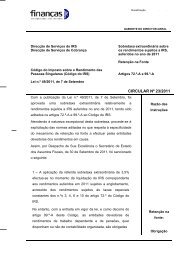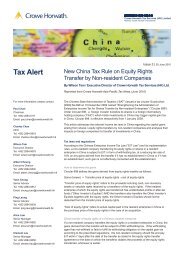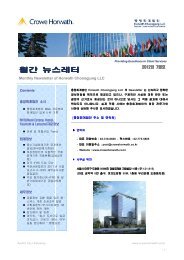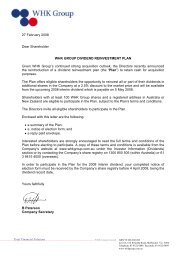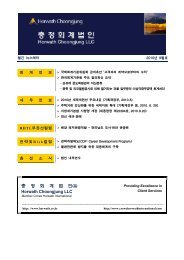Guidance Paper - The Institute of Risk Management
Guidance Paper - The Institute of Risk Management
Guidance Paper - The Institute of Risk Management
You also want an ePaper? Increase the reach of your titles
YUMPU automatically turns print PDFs into web optimized ePapers that Google loves.
Multiple risk<br />
appetites<br />
209<br />
We believe that it is almost<br />
impossible to encapsulate risk<br />
appetite for a business as a<br />
whole in a phrase such as “risk averse” or<br />
“risk welcoming”. Such phrases fail to<br />
recognise that in all but the very simplest<br />
businesses there is inevitably more than<br />
one risk appetite. <strong>The</strong>re might be one risk<br />
appetite for selling a particular product,<br />
and a different appetite for taking risk<br />
while selling another product. <strong>The</strong>re<br />
might be one appetite for regulatory risk<br />
in one country and another appetite in a<br />
different regulatory regime. It seems<br />
inevitable that risk appetite has to be<br />
capable <strong>of</strong> being expressed differently for<br />
different classes <strong>of</strong> risk and at different<br />
levels <strong>of</strong> the organisational structure.<br />
However, we believe that there needs to<br />
be a cross-check between risks and a<br />
holistic view at the top <strong>of</strong> the<br />
organisation.<br />
<strong>Risk</strong> culture<br />
We think that it is worth<br />
211 reflecting on risk culture,<br />
which most risk pr<strong>of</strong>essionals<br />
recognise as an important area<br />
<strong>of</strong> debate. A good risk culture will<br />
facilitate the better management <strong>of</strong> risk<br />
and indeed will underpin an organisation’s<br />
ability to work within its risk appetite (see<br />
‘<strong>Risk</strong> Culture’ box for more discussion).<br />
Symptoms <strong>of</strong> a poorly functioning risk<br />
culture include:<br />
• Leadership sends inconsistent or<br />
unclear messages on acceptable<br />
levels <strong>of</strong> risk<br />
• <strong>Risk</strong> is perceived to be managed<br />
intuitively and not discussed in<br />
making decisions<br />
• Provided business results are delivered,<br />
few questions get asked regarding<br />
what might go wrong,<br />
• and there is little or no sanction<br />
for those taking inappropriate levels<br />
<strong>of</strong> risk.<br />
To meet the criteria <strong>of</strong><br />
212 embedding risk management<br />
it is important for<br />
remuneration to be directly<br />
linked to good control <strong>of</strong> risks. It is<br />
recognised that not all risk appetites<br />
and thresholds will be quantitative,<br />
but where they are they can be directly<br />
linked to bonus payments. In this way<br />
when thresholds are breached the<br />
business unit and associated team<br />
members will be able to see the impact<br />
<strong>of</strong> decisions taken. Conversely, good risk<br />
management can be evidenced and<br />
appropriately rewarded.<br />
Key terms and<br />
phrases<br />
213<br />
In this section we have<br />
introduced five key phrases,<br />
which we are defining as set<br />
out in the following table:<br />
<strong>The</strong> framework that we have<br />
210 depicted in Figure 6 above<br />
incorporates the ability to<br />
represent multiple risk<br />
appetites in two ways:<br />
• In the first instance it recognises that<br />
there will be different appetites for<br />
risk at different levels. <strong>The</strong> diagram<br />
explicitly shows risk appetite at a<br />
strategic, tactical and operational<br />
level. <strong>The</strong> next section <strong>of</strong> this paper<br />
discusses this in more detail. However,<br />
in essence the importance <strong>of</strong> this<br />
is that it binds together the two<br />
elements <strong>of</strong> the propensity to take risk<br />
and the propensity to exercise control.<br />
<strong>The</strong> essence <strong>of</strong> the framework is that<br />
proportionately more time, effort and<br />
resources are devoted to taking risk at<br />
a strategic level, and proportionately<br />
more time, effort and resources are<br />
devoted to exercising control at an<br />
operational level <strong>of</strong> the organisation.<br />
• An important aspect <strong>of</strong> the framework<br />
is that it requires a mechanism for<br />
measurement. This will facilitate<br />
comparison <strong>of</strong> different risk types, and<br />
allow for some form <strong>of</strong> aggregation<br />
across the organisation.<br />
Phrase<br />
<strong>Risk</strong> capability<br />
<strong>Risk</strong> capacity<br />
<strong>Risk</strong> management<br />
maturity<br />
Propensity to take risk<br />
Propensity to exercise<br />
control<br />
Meaning<br />
A function <strong>of</strong> the risk capacity and risk management<br />
maturity which, when taken together, enable an<br />
organisation to manage risk in the pursuit <strong>of</strong> its long term<br />
objectives.<br />
<strong>The</strong> resources, including financial, intangible and human,<br />
which an organisation is able to deploy in managing risk.<br />
<strong>The</strong> level <strong>of</strong> skills, knowledge and attitudes displayed by<br />
people in the organisation, combined with the level <strong>of</strong><br />
sophistication <strong>of</strong> risk management processes and systems in<br />
managing risk within the organisation.<br />
<strong>The</strong> extent to which people in the organisation are<br />
predisposed to undertaking activities the impact, timing<br />
and likelihood <strong>of</strong> which are unknown, and which is<br />
influenced by financial, cultural, performance and ethical<br />
considerations.<br />
<strong>The</strong> extent to which people in the organisation are<br />
predisposed to take steps to change the likelihood,<br />
timing or impact <strong>of</strong> risks, influenced by financial, cultural,<br />
performance and ethical considerations.<br />
21






